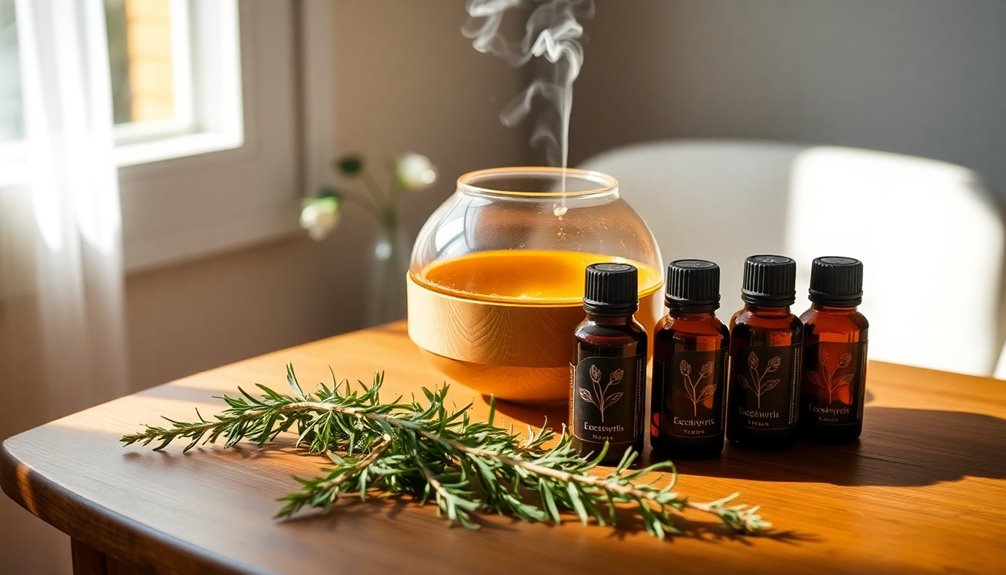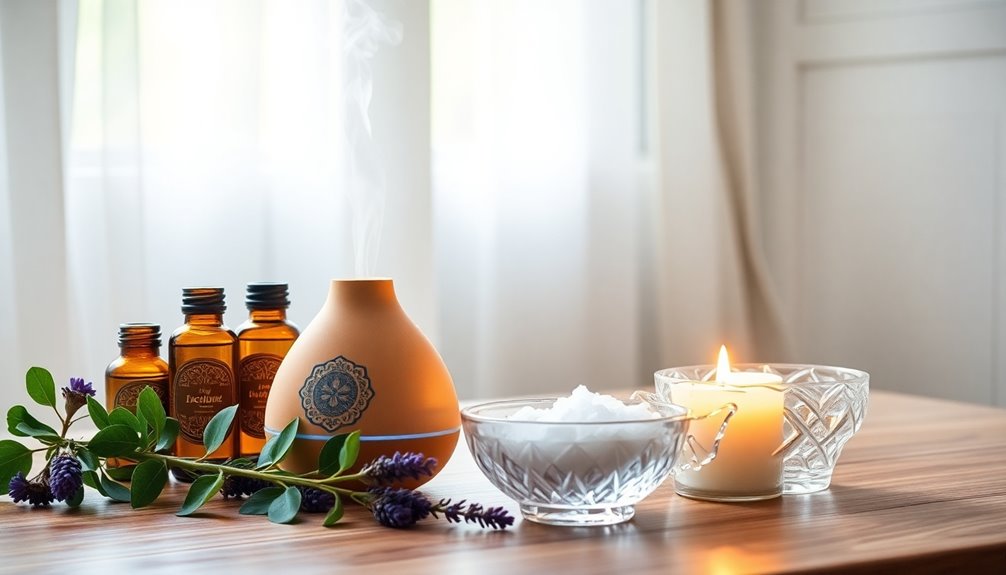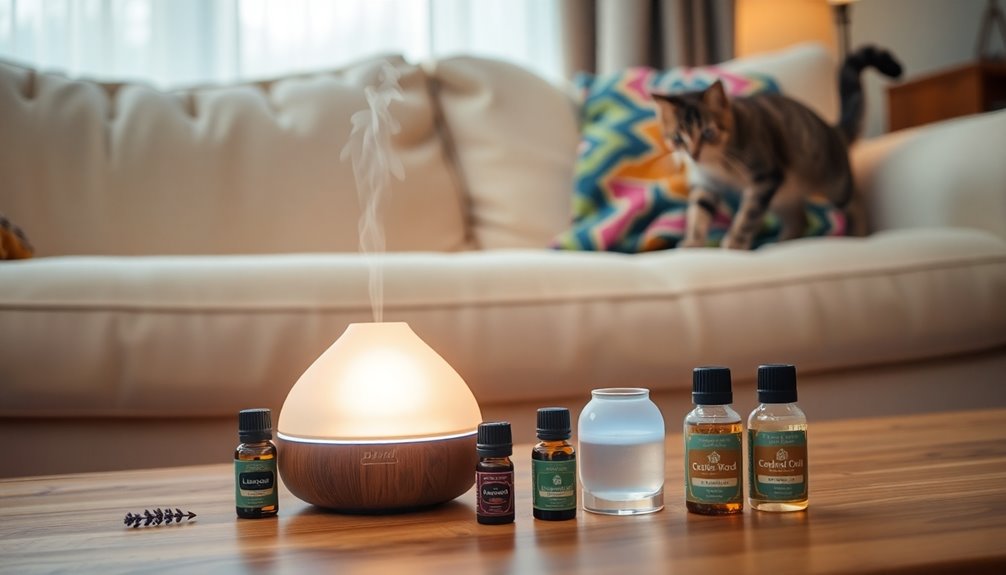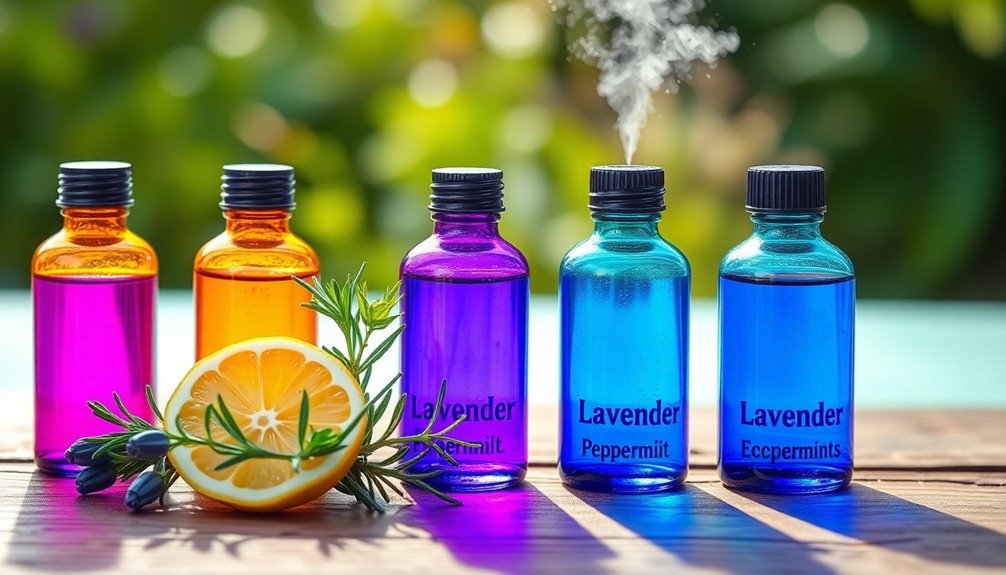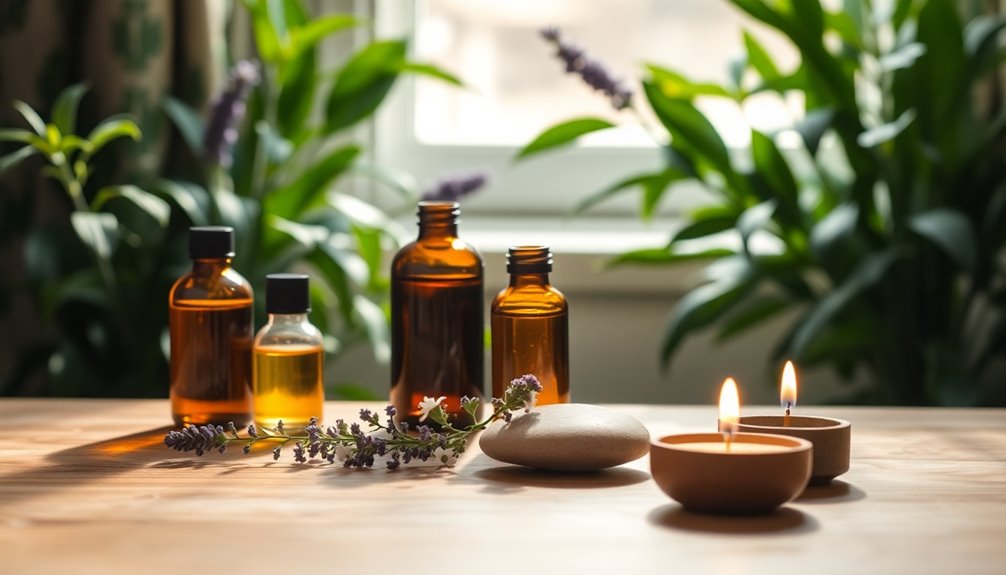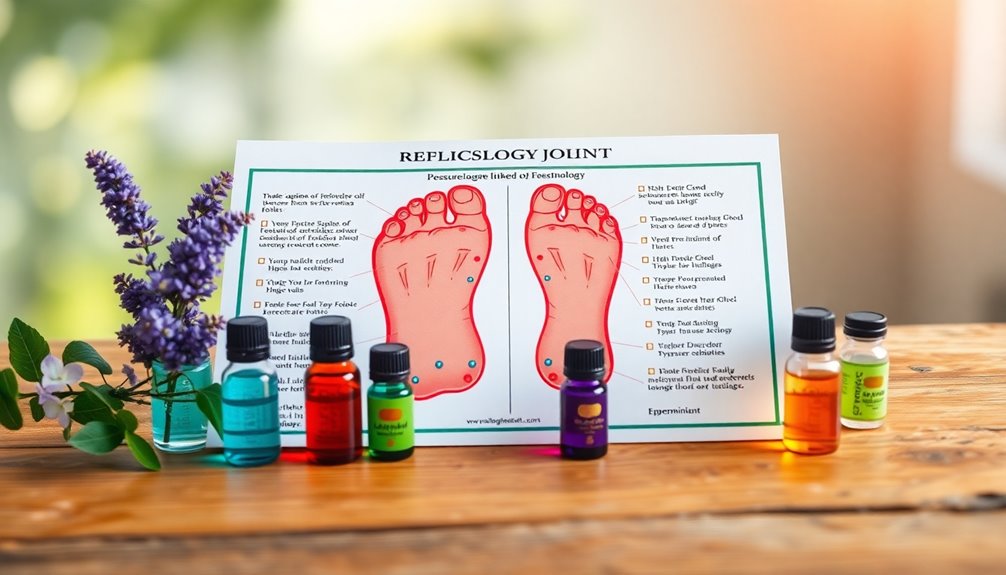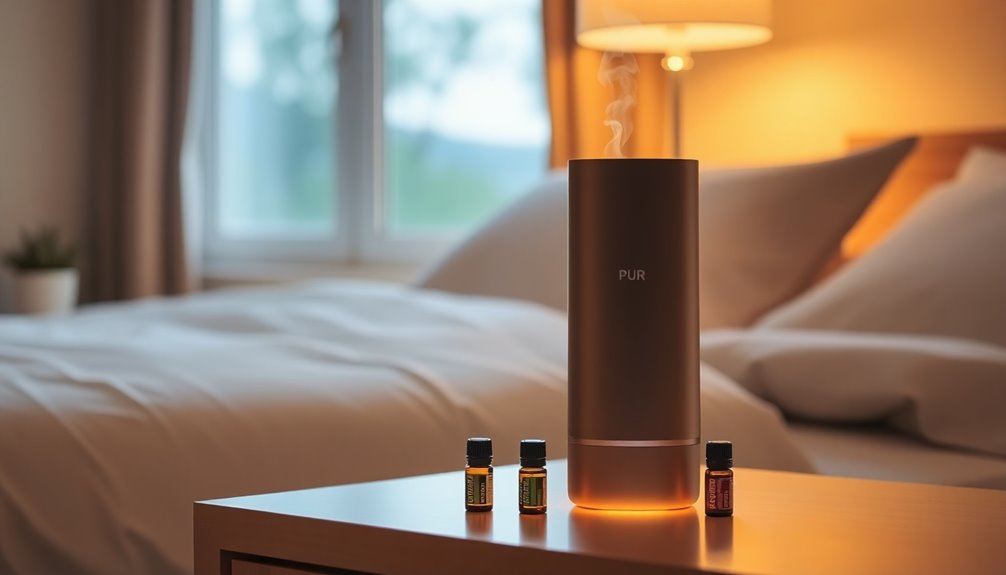If you're dealing with bursitis, essential oils can be a great natural remedy for inflammation relief. Oils like eucalyptus, ginger, lavender, and peppermint are known for their anti-inflammatory properties. You can dilute these oils with a carrier oil and apply them topically or use them in a warm compress. Inhaling eucalyptus or ginger can provide quick comfort, too. Just remember to do a patch test first to avoid skin irritation. Incorporating proper application methods and precautions is key, and you might find additional tips to maximize your relief and enhance your healing journey.
Key Takeaways
- Eucalyptus and ginger essential oils are effective for reducing inflammation and pain associated with bursitis.
- Apply diluted essential oils topically using a 3% dilution with carrier oils like almond or jojoba.
- Warm compresses infused with essential oils can soothe inflamed areas and promote healing.
- Regular gentle stretching and low-impact exercises strengthen muscles around affected joints, aiding recovery.
- Always conduct a patch test for allergies before using essential oils and consult a professional if needed.
Understanding Bursitis
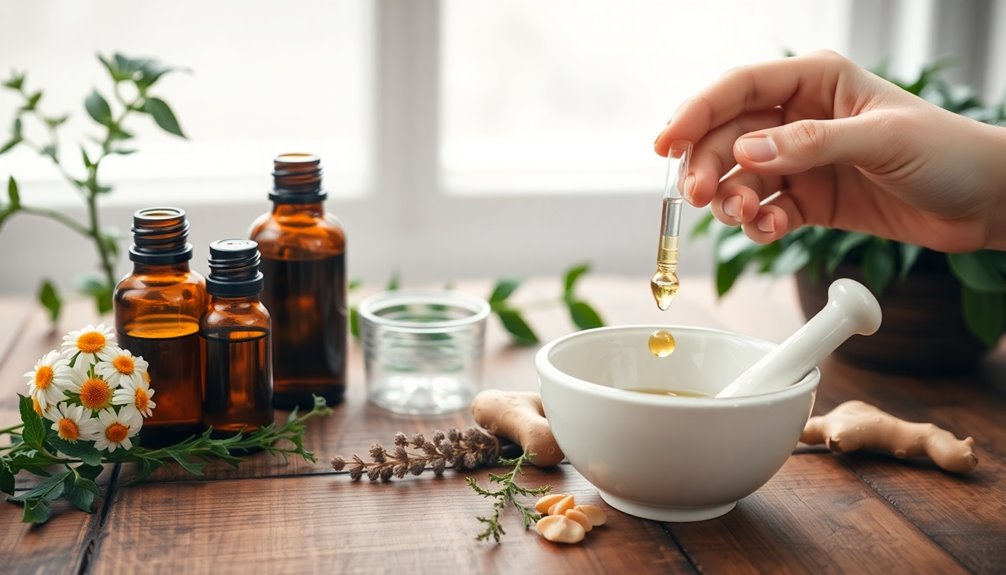
Bursitis is a painful condition caused by the inflammation of small sacs called bursae, which cushion your joints. This inflammation often leads to pain, swelling, and limited movement, particularly in areas like your shoulders, elbows, hips, and knees.
Trochanteric bursitis, a specific type, affects the hip and is more common in women due to anatomical factors. You might develop bursitis from repetitive motion, prolonged pressure, or injury, and it's often linked to conditions like arthritis.
Accurate diagnosis by a medical professional is vital for effective treatment. Options may include physical therapy, anti-inflammatory medications, or corticosteroid injections to alleviate pain and reduce inflammation.
Understanding bursitis is essential to managing your symptoms effectively.
Essential Oils Overview
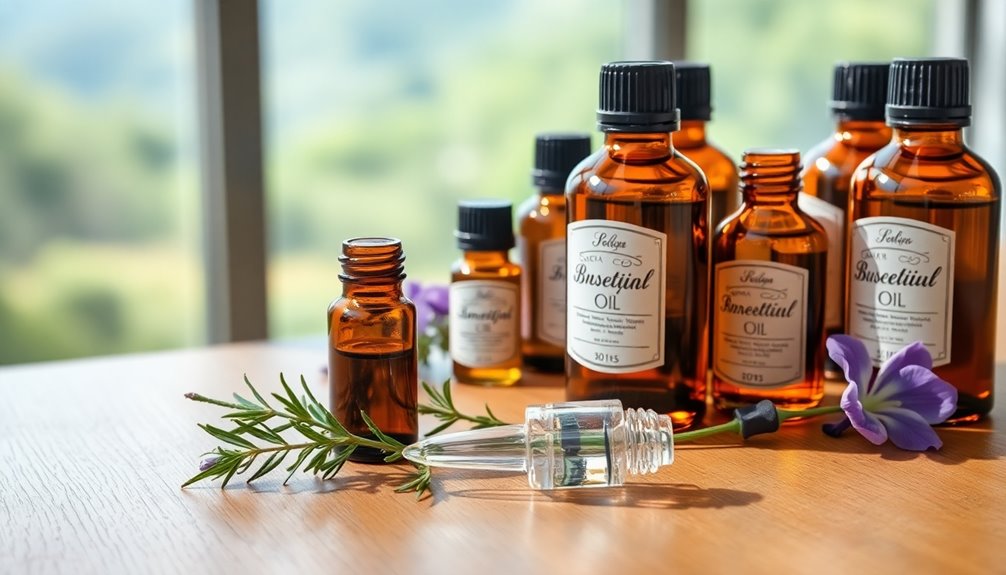
Essential oils are powerful plant extracts that have gained popularity for their natural healing properties. Known for their potential anti-inflammatory benefits, essential oils can be a great choice for alleviating symptoms of bursitis. Oils like eucalyptus, lavender, and ginger have scientific backing for reducing inflammation, with eucalyptus oil being particularly effective as a decongestant. Essential oils provide natural antibacterial and antifungal properties, making them versatile for various health needs. Regular use can enhance scalp health and promote overall wellness. You can use them through inhalation, topical application, or diffusion, each method providing unique absorption benefits. Always remember to dilute essential oils properly to prevent skin irritation. It's wise to consult a healthcare professional before starting essential oils, especially if you have underlying health conditions, or if you're pregnant or nursing. Additionally, proper dilution guidelines are essential for safe usage to minimize any risk of irritation.
| Essential Oil | Anti-Inflammatory Benefits | Common Application Methods |
|---|---|---|
| Eucalyptus | Reduces swelling | Inhalation, Topical |
| Lavender | Calms pain | Diffusion, Topical |
| Ginger | Alleviates discomfort | Topical, Inhalation |
| Peppermint | Soothes soreness | Topical, Diffusion |
| Frankincense | Promotes healing | Inhalation, Topical |
Recommended Essential Oils
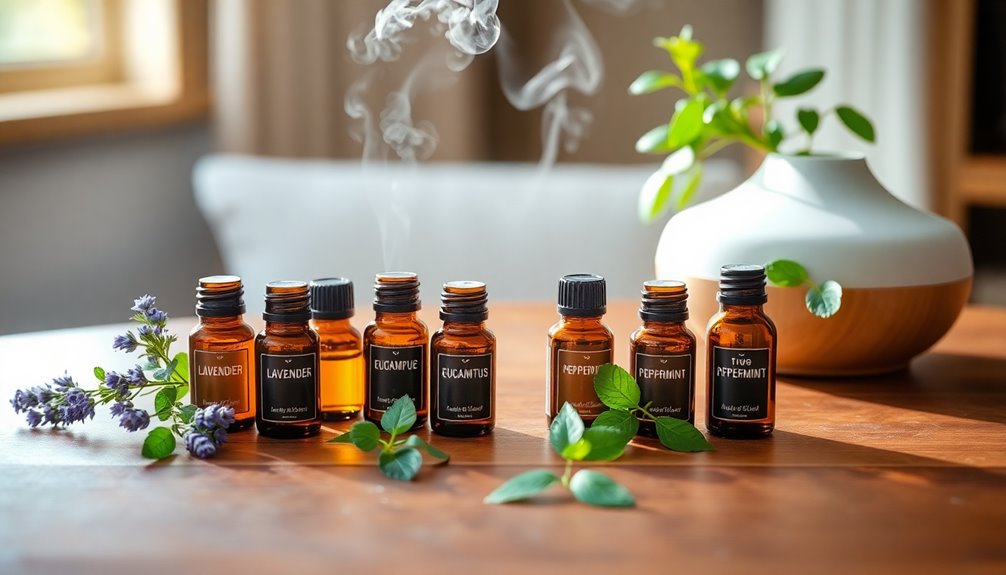
When dealing with bursitis, certain essential oils can really help reduce inflammation and pain. Oils like eucalyptus, ginger, lavender, and peppermint offer various benefits that you can use for relief. Additionally, the use of herbal remedies has been historically recognized for promoting overall health and vitality, which may complement the benefits of essential oils. Moreover, incorporating mindfulness practices can enhance your overall well-being during the healing process. It's important to remember that proper dilution guidelines should always be followed to ensure safe and effective application of these oils. Furthermore, maintaining adequate sleep is crucial for recovery and can help support your body's healing processes.
Anti-Inflammatory Essential Oils
If you're looking for natural relief from the pain and inflammation of bursitis, several anti-inflammatory essential oils can help.
Ginger essential oil is particularly effective due to its gingerols, which can greatly reduce inflammation and chronic pain. Regular use of essential oils can create a positive environment that supports recovery and reduces stress. Additionally, ginger essential oil has been shown to complement traditional treatments for inflammation, and its use is linked to significant reductions in stress levels, which can further aid healing.
Eucalyptus oil offers analgesic properties, making it great for alleviating pain and swelling, especially after surgery or for muscle relaxation. Its effectiveness in promoting respiratory relief can also contribute to overall comfort during recovery.
Lavender oil not only promotes relaxation but also lowers inflammatory cytokines, aiding in the reduction of bursitis-related inflammation. The calming effects of lavender can help enhance the quality of sleep, which is essential for recovery.
To maximize the therapeutic benefits while avoiding skin irritation, dilute these essential oils to about 3% with a carrier oil before applying them topically.
Incorporating these oils into your routine may provide the relief you need. Additionally, considering natural remedies alongside essential oils can enhance inflammation relief and promote overall wellness.
Application Methods for Relief
For effective relief from bursitis symptoms, you can explore various application methods that harness the power of specific essential oils.
Start by applying essential oils topically in a 3% dilution with a carrier oil, like almond or jojoba, to help relieve discomfort and reduce swelling and pain.
Inhaling oils such as eucalyptus or ginger can provide immediate relaxation and relief.
A warm compress infused with essential oils can soothe inflamed areas, while adding essential oils to a bath allows for systemic absorption, enhancing their effects.
Finally, utilizing essential oils through massage on the affected area can boost circulation and alleviate tension, supporting overall joint health.
Methods of Application
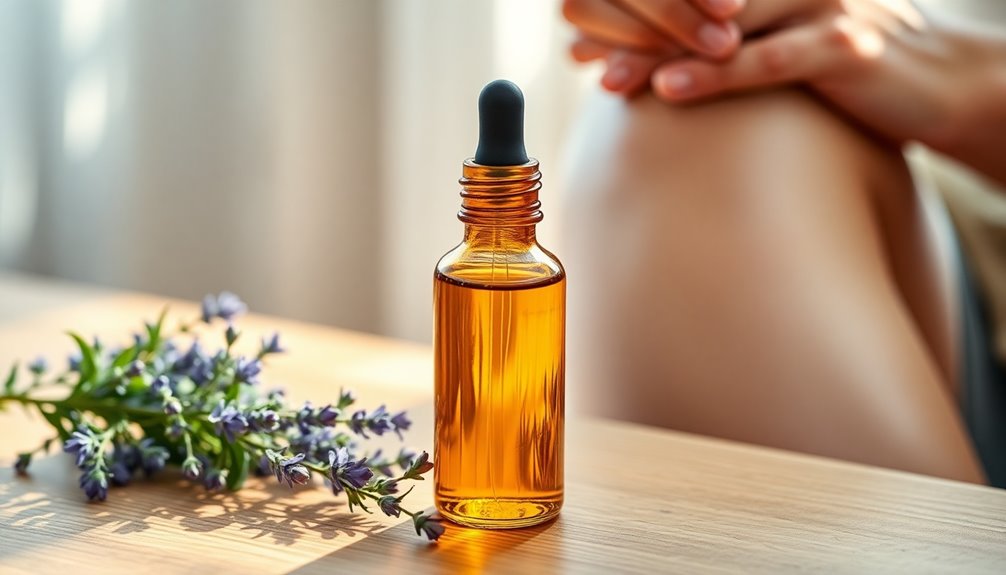
To effectively manage bursitis symptoms, you can explore various methods of applying essential oils that suit your preferences and needs.
One popular method is topical application, where you dilute essential oils with a carrier oil at a recommended concentration of 3-5%.
For quick relief, consider inhalation via diffusers or steam, allowing rapid absorption into your bloodstream.
If you're targeting localized pain, try using a compress; soak a cloth in diluted oil and place it on the affected area.
Bathing with essential oils in warm water can also provide systemic absorption and relaxation, helping ease inflammation.
Just remember to perform a skin patch test before full application to guarantee you don't have any sensitivity or allergic reactions.
Safety Precautions
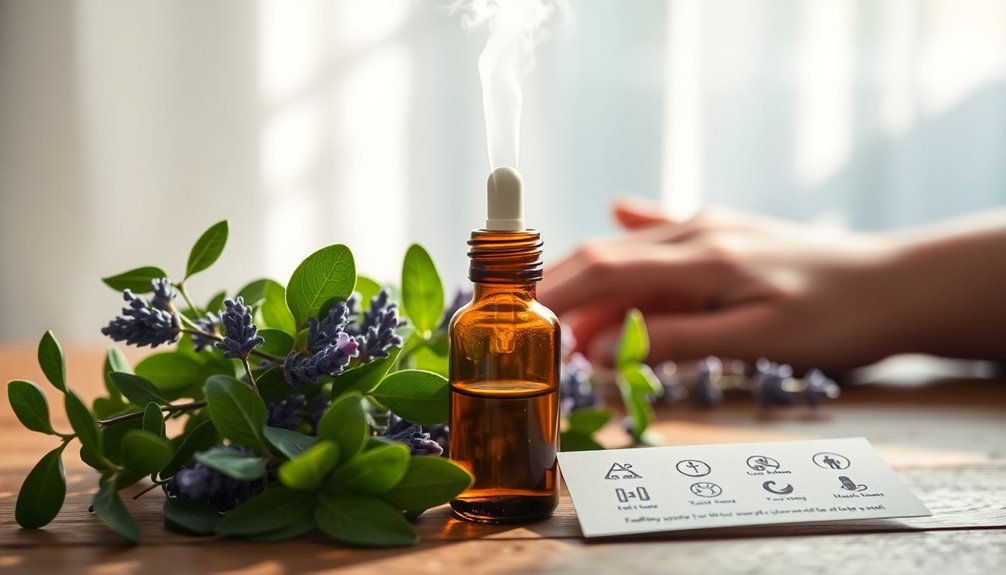
When using essential oils for bursitis, it's vital to dilute them with a carrier oil to avoid skin irritation—aim for a 3% dilution.
Always perform a patch test first to check for any allergic reactions before applying more broadly.
Dilution Guidelines
Diluting essential oils is essential for safe topical application, with a recommended ratio of 3%—that's about 10-15 drops of essential oil per ounce of carrier oil.
Coconut oil makes an excellent choice as a carrier due to its soothing properties. Always follow dilution guidelines to minimize the risk of skin irritation.
Before applying any diluted mixture, perform a patch test on a small skin area to check for potential allergic reactions or sensitivity. This step is important to guarantee your skin can handle the essential oils.
Remember, never ingest essential oils unless guided by a professional, as improper use can lead to toxicity.
Store your oils properly, away from sunlight and children, to keep them effective and safe.
Allergy Considerations
Although essential oils can provide relief for various conditions, it's crucial to be aware of potential allergic reactions.
When considering allergy considerations, you should conduct a patch test before applying essential oils fully. If you have known allergies to specific plants, be cautious with oils derived from them to avoid adverse reactions.
Some essential oils, like lavender and tea tree oil, can cause skin irritation or allergies, especially in sensitive individuals.
If you're pregnant or nursing, seek medical advice before using any essential oils, as some may pose risks.
Finally, always store essential oils safely away from children to prevent accidental exposure, which can lead to allergic reactions or toxicity. Additionally, consult a professional if you have a history of food allergies to ensure safe usage of essential oils in your routine.
Additional Tips for Relief

To enhance your recovery from bursitis, consider incorporating gentle stretching exercises into your routine. These exercises help relieve muscle tension and improve flexibility, vital for reducing inflammation. You can also apply heat or ice, depending on what feels best for you. Using essential oils like ginger and peppermint in a diluted form can alleviate pain when massaged into the affected area. Maintaining good posture during activities is essential to help manage symptoms and prevent irritation. Regular, low-impact exercises, like walking or swimming, can strengthen hip muscles and reduce the chance of recurrence. Additionally, be mindful of proper toilet maintenance routines to prevent any unnecessary strain on your body while using the facilities.
| Tip | Benefit | How to Implement |
|---|---|---|
| Gentle Stretching | Improve flexibility | 10-15 minutes daily |
| Heat/Ice Application | Reduce pain and inflammation | Apply as needed |
| Use Essential Oils | Alleviate pain | Massage into area |
| Maintain Good Posture | Prevent irritation | Be mindful during tasks |
Frequently Asked Questions
What Essential Oils Are Good for Bursitis?
If you're dealing with bursitis, consider using eucalyptus, ginger, and lavender essential oils.
Eucalyptus can help reduce pain and inflammation, while ginger is known for its strong anti-inflammatory properties.
Lavender not only aids in managing discomfort but also offers a calming effect.
When applying these oils, make sure to dilute them to around 3% with a carrier oil for safe topical use.
You've got natural options to alleviate your symptoms!
What Is the Best Natural Anti-Inflammatory for Bursitis?
When it comes to tackling bursitis, you can't go wrong with natural anti-inflammatories!
Imagine a world where pain fades away like a distant memory. Turmeric, packed with curcumin, is a superstar in reducing inflammation.
Ginger's fiery essence also works wonders, soothing your aches and discomfort. Don't forget about omega-3-rich fish oil; it's like a gentle wave calming your joints.
Combine these remedies with a balanced diet, and you'll feel unstoppable!
What Is the Most Anti-Inflammatory Essential Oil?
When you're looking for the most anti-inflammatory essential oil, consider ginger oil.
It's packed with gingerols, which are known for their powerful ability to reduce inflammation.
Lavender oil's calming effects also help by lowering inflammatory cytokines.
Eucalyptus oil can relieve pain and swelling effectively, while frankincense oil may offer additional anti-inflammatory benefits.
Don't forget peppermint oil, as its menthol content soothes muscle pain and reduces inflammation too.
Try these oils for relief!
How to Use Frankincense for Inflammation?
Imagine a soothing balm for your aching joints—a gentle whisper of relief.
To use frankincense for inflammation, dilute 10-15 drops in an ounce of carrier oil, like jojoba or almond. Massage this blend onto the affected area, letting its warmth envelop you.
For added benefits, consider inhaling its calming aroma to ease stress.
Don't forget to conduct a patch test first, ensuring your skin welcomes this fragrant ally without irritation.
Conclusion
Incorporating essential oils into your routine can be like adding a soothing balm to a raging storm of bursitis. With their natural anti-inflammatory properties, these oils can help calm the chaos in your joints, bringing you back to a place of comfort and ease. As you embrace these fragrant allies, remember to tread carefully and listen to your body. Soon enough, you'll feel the gentle whispers of relief guiding you toward a more vibrant, pain-free life.

